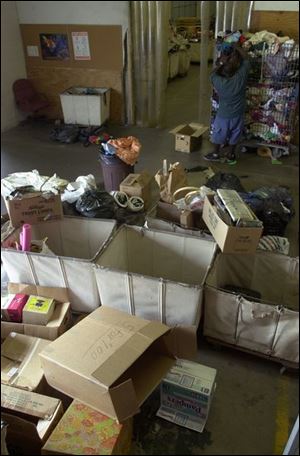
Goodwill offers more to people than bargains
8/20/2001
Patrick Hitt of South Toledo sorts the donated clothing at the Goodwill Industries outlet on South Reynolds Road.
Goodwill Industries helps people find jobs and self-esteem, but the organization doesn't touch just people's lives.
It touches their clothes.
The seven stores in northwestern Ohio accept donations of clothing and household items and sell them at a low cost. Inexpensive clothing and things for the home might please bargain shoppers, but the true goal of Goodwill often is lost in the clutter of good deals.
Goodwill's primary mission is to help people with disabilities or work-related disadvantages by providing job assessment, training, and placement. The retail stores, while the most visible and profitable arm of the agency, help to make that possible.
“Goodwill Industries is more than just a store,” said Susanne Fredericks, development and industrial services director for Goodwill Industries of Northwest Ohio. “Your donations turn into revenue.”
The retail stores generated 51 percent of the organization's nearly $5.5 million in income in 2000. Almost 20 cents of each dollar spent in stores fund the work force development program, which served 500 people last year, 225 of whom became employed.
In 2000, nearly 129,000 people donated more than 5 million tons of textiles, housewares, furniture, and domestic goods.
At the store on Reynolds Road, the staff sorts and hangs at least 866 clothing items daily. It's the most visible part of the operation.
A workout suit began its journey through Goodwill when Bjorn Schweinsberg of Holland donated two large bags of clothes last week to the Reynolds store.
“It's easy to donate. You just drop the stuff off,” Mr. Schweinsberg said.
Mr. Schweinsberg, 21, lives with his parents but is about to move to an apartment. His parents are moving too, so he brought in donations from the whole family to lighten the moving load.
When Mr. Schweinsberg drove up to the entrance of the donation center in the back of the Reynolds store, Patrick Hitt of South Toledo leaped into action.
“It gets hectic sometimes, but there are always a few customers that come in and make your day,” said Mr. Hitt, who has worked at Goodwill for five months.
He recalled one woman who donated clothes on a very hot day, and saw the rivulets of sweat dripping down his face. She returned an hour later with a large pitcher of ice water and a root beer float.
“I really can't stand root beer, but that was the best float I ever tasted in my life,” Mr. Hitt said.
After passing through Mr. Hitt's hands, clothes head to Yvonne Burkhalter, who separates acceptable items from clothes that are “not up to par.”
Slightly ripped, stained, dirty, or extremely creased clothes aren't sold at Goodwill. The store doesn't wash donated clothes, so it only sells items that look clean enough to sell to customers.
Discarded clothes that are still wearable, though, are not tossed into the trash. They go to impoverished people overseas, said Casey Beckman, manager of the Reynolds store.
“These will sell,” Ms. Burkhalter said as she passed the workout suit, which formerly belonged to Mr. Schweinsberg's tennis-playing mother. The donated items are hung on a rack and wheeled onto the sales floor.
“We have customers actually run to the racks,” Ms. Beckman said. “They know it's the newest stuff coming out.”
While Goodwill stores definitely benefit people who cannot afford more upscale stores, middle class people are Goodwill's core customer base.
“Many people still think we are only selling to the needy,” said Amy Wachob, retail operations director. The retail store's target customer is a 30 to 40-year-old woman with two children and average to high income, she said.
“I see people come in who work downtown at the courthouse. They go straight to our suits, and they clean up,” said Pamela Smith, a cashier at the Reynolds Road store.
Ann Weaver needed a picture frame when she walked into Goodwill last Monday. She lives in Weston, Ohio, but was in Toledo for the day and stopped at Goodwill with a friend to look for a frame.
Mrs. Weaver said she shops at Goodwill a few times a year when she needs something specific. She noticed the black-and-white workout suit hanging in the window, and purchased it for $5.50.
“It's very nice quality, just like new. It's a good buy. It probably cost about $50 originally,” Mrs. Weaver said.
But it's not all about clothes at Goodwill.
The work force development program provides janitorial training, food-service training, and a business certificate program, including medical transcription training. Programs vary in cost, which often are paid for by a referring agency.
Agencies that refer people to Goodwill include the Bureau of Vocational Rehabilitation, Veterans Administration, Department of Child and Family Services, private rehabilitation facilities, insurance companies, and homeless shelters.
Goodwill's other major arm is the contracts division, which contracts light-industrial services to such firms as Dana, Maumee Bay Brewing Co., Tony Packo's, and DaimlerChrysler/Jeep.
Contracts generated $1.6 million in revenue last year, but DaimlerChrysler/Jeep recently cancelled a contract that generated 40 percent of that revenue.
In March, 2000, Goodwill Industries of Northwest Ohio began participating in the virtual auction web site www.shopgoodwill.com. The web site, which is similar to E-Bay, allows shoppers to view digital photographs of goods from Goodwill stores across the United States and bid on them, then have them shipped to their homes.